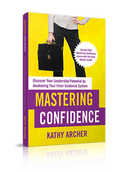|
Nonprofit leaders make a lot of decisions as they run their nonprofit organizations. Decision-making is a thinking process. However, we often make decisions without consciously thinking about our decision and how we are making it. In fact, many of us don't even realize we are or have made a decision.
Leaders make many critical decisions daily Some sources suggest that we make about 35000 decisions a day. As a leader, I'm going to guess that there is a chance you make a few more decisions than most employees. And chances are your decisions hold a lot more weight and responsibility. If my assumptions are accurate, it's likely important that you slow down your decision-making process and be more intentional about it. Decision-making help To help you be more intentional with your decision-making process, I've listed 10 questions below to help you make your next leadership decision. 10 important questions you must ask before your next decision 1 – What is the decision I am making? 2 – Is it my decision to be made?
3 – When does this decision need to be made by?
4 – What are the options or sides that I am considering?
5 – Do I have all of the information I need? 6 – Who will this decision impact?
7 – Will my decision set off a ripple of other issues that will require decision-making?
8 – Am I making a value-based decision?
9 – How important is this decision?
10 – Will I be able to live with my decision? Learn to be an intentional decision maker Processing the above questions will help you be more intentional in your decision-making. However, you may also want to think strategically before making your decision. In this article, I share 3 strategies to help you think more strategically. The bottom line is that you need to create opportunities to think as a leader. Don't wait to find time to think. Schedule thinking time into your calendar! More support to help you make good decisions In my membership site, The Training Library, I offer additional training to help you make decisions. Here are some you may be interested in checking out:
A big part of a leader's job is thinking Give yourself time and space to think! And don't be afraid to tell others that's what you are doing! Having the confidence to communicate your role is an essential aspect of Leadership. p.s. To help you understand how your values and creating thinking time play a role in your decision making, tune into Episode # 72 of the podcast where I talked to David Phu about Ethical Video Creation
0 Comments
I have no time to think! I wish I had time to think about things before deciding on which way to go. If only I could have some space to think clearly!
Do any of those sound familiar? If you are in leadership, I bet you are nodding your head! All too often, we feel rushed to make decisions, deal with problems and move things forward. Yet, there is a little voice inside us, asking for a bit more time. At least there is in my head! This kind of rushed thinking is often more unconscious than conscious. In the last blog post, I talked about what unconscious thought can do to us and how it can drag us into worry and overwhelming anxiety. Today I want to shift into intentional thinking and how it can help you be more purposeful, planful and productive. There are many kinds of conscious or intentional thinking. Over the next few weeks, I'll talk about conscious thinking types such as:
For this article, though, I want to start with the difference between strategic thinking and planning, sometimes called strategic planning. Do you have time to strategize or plan? Most women leaders struggle to find time for either, leaving them feeling frazzled, disconnected and whacking moles. Reacting to a to-do list, chasing down meetings and solving daily problems is neither thinking strategically nor mindfully planning things out. We often start with planning before we've done the strategizing. When we do find time, we often start with planning. Planning is setting out the steps and the process for getting something done. But we've often missed the strategic thinking part, considering how all of the dots fit together. How planning before strategizing can get you in trouble! Imagine your program just received a new pocket of funding. You know you need to work on it right away, so you start to plan how to spend it. First, you think about which staff has the capacity to add a few more hours for this program. Then, you grab a calculator and start figuring out the math for how many clients they can fit in. You know you have a conversation with them next week, so you want to figure this out before you meet with them so you can get moving right away. But wait a minute. Is that the right person for the role? Yes, they may have the capacity, but what else is happening for them? How does their capacity now fit in with a possible expansion of another program or reduction of a third? And what is the purpose of this program? Does it actually align with this employee's strengths, interests and future career trajectory? Would it split who they report to, now having two supervisors? What about the fact that they just told you they are expecting. I know, you've got a few months to figure that out, so you'll deal with it then, right? If you've made these kinds of quick decisions before thinking it out, you know how quickly they can backfire or cause you more headaches in the long run! What is strategic thinking? When you are strategically thinking, you are not yet tied to a decision. You are open. Strategic thinking is a right-brain activity. It's the thinking you do when driving or leaning back in your chair. Strategic thinking isn't necessarily about doing something specific yet because you don't know what the specific is. Instead, it's a high-level thinking process where you step back and see all the moving parts and consider how they fit together, where the dots need to be connected, and how they fit in with your mission, vision, and organizational goals. What is strategic planning? Strategic planning is when you are closer to the task at hand, breaking apart and deciding what parts need doing, when, and who can help. Strategic planning is a left-brain thinking activity. Here's an example of strategic thinking and planning in action Let's consider another example. Perhaps you are wondering if you should move offices. When you think strategically about moving offices, you might consider how changes would affect the team members, clients, and community partners. You might brainstorm what you'd like to have access to for future programming. When you think strategically, you might think about costs, people to talk to, and considerations. High-level thinking At this stage of the thinking process, you don't tie to moving or not moving. You are just considering options. Maybe you are also considering staying in the same location, but having more of your staff working from home. But, again, you are just thinking about it at a very high level. Keep coming back to high-level thinking At this point, you would keep coming back to the bigger reason for considering a move in the first place. Why is this a consideration? How does it fit in with your program's overall mission and vision? What about your contract or funding obligations? You make sure you look at the impact that a decision to change your location possibly could have on
Step one planning You may make a decision and then need to create a plan to move forward with a move. But even before then, you may make an earlier plan around getting some input from others to see if it's even viable and of interest. You'd then need to plan how to do that. To plan the first stage, you may ask yourself some of these questions:
You might be wondering, though, how to be a more strategic thinker and how to no when it's time know when it's time to move to strategic planning. I've got you covered with the steps below. 3 strategies to help you think more strategically
How to know you are ready to move to the planning stage Consider your answers to the following questions to know if you may need to stay in strategic thinking a wee bit longer.
TBH, Strategic thinking and planning often go hand-in-hand Note that these two types of thinking don't happen in a linear process. Strategic thinking and strategic planning often overlap. The point here is to help you see the difference. Write it down when you have a planning thought, but don't get hung up on it. p.s. Inside The Training Library membership site are tons of tutorials, templates and tools to help you think strategically and plan. For example, you'll find resources to help you plan 1-1 meetings and staff meetings. You'll also discover processes that help you plan to keep your emotions in check during difficult conversations. And you'll strategically learn how to plan your leadership growth, impact and legacy. Become more strategic and plan with intention here. Thinking. As a nonprofit leader, you probably spend a lot of time thinking. But are you doing the right kind of thinking at the right time?
Over the coming weeks, I will dive into different kinds of thinking. I want to start with unconscious thought. First, let's talk about how unconscious thinking can get you into trouble and then where you probably need to do more of it. Unconscious thinking that is not helpful Let's start with what we generally think of as unconscious thinking. This is when your mind gets away from you. Generally, we're talking about worry, anxiety and those racing thoughts that keep you up at night. Here's the trouble with unconscious thinking as a leader. It can keep you stuck. Repetitive, negative thoughts left unchecked keep us stuck Unconscious thinking left unchecked can circle around and around and around. You are digging into a deeper rut that is hard to get out of. Consider these thoughts
Now put any of these thoughts on loop.
If that loop of thoughts goes on unconsciously in the back of your mind for hours, days and months, you can see how the rut gets deeper and deeper. It's not as easy as "just think positively." Many social media posts tell you to think positive – Everything is always working out for me. But it's not that easy! You might say at once, but you'll fall back into that rut fast and be back to, Oh my God, I'm so overwhelmed. Unconscious thoughts also keep us stuck in beliefs about our employees, community, funders, and ability to have funding to meet our needs. I often hear the mantra from leaders that they are expected to do more with less. And while there is undoubtedly an incredible amount of truth to that statement, repeating it out loud continuously, in our minds and aloud to other people regularly keeps the belief alive and well. To get out of repetitive negative thinking traps, you need to shift to conscious thinking When you realize you find yourself stuck in a repetitive negative thinking trap, you need to shift to conscious thinking. For example, instead of staying stuck in the scarcity mindset of never enough time, money, and staff, you need to shift your mind to examine the following questions consciously:
How to consciously think about your employee's contributions Another typical thought you may have is feeling like you are chasing your team down to get them to do their work. When we experience irritation in our body, our unconscious thoughts may have us stuck in believing those thoughts are true. When our thinking stays unconscious, it's hard to look for times when our employees take responsibility, pitch in, or take the lead on something. We both know the "positive" is generally not where our mind goes when trying to fall asleep at night. To consider how your employees are contributing takes more conscious thinking. I doubt you've dug a rut considering the answers to these questions:
The type of unconscious thinking that IS helpful In the coming weeks will talk about ways to be more intentional and conscious in our thinking. But before we go there, I want to talk about the other unconscious thought that we perhaps don't do enough of. This kind of unconscious thought is what I call creative thinking. Now I know some of you are rolling your eyes and think I'm not a creative person and creativity does not come into my job. I beg to differ! The unconscious thinking that we've been talking about above makes me think about someone pacing back-and-forth and digging a deeper and deeper rut in the ground. Creative thinking is light and easy Instead, when I think of unconscious creative thinking, I imagine it like a ladybug crawling around on a plant for a few moments, then flying away to the next one and crawling around and exploring it before she flies away again to another location. The red and black ladybug is curious. I imagine she's somewhat relaxed and perhaps even enjoying herself. You need to do more of that! Here's what you can do with creative thinking This kind of creative thinking is when you come up with the idea for an activity at a staff meeting in the shower. Or you think about a way to organize the annual report's stats that show it in a more visually appealing way. Sometimes the creative thoughts come to us when we're cooking, driving or out for a walk. And generally, we're not trying to find a solution. We didn't even know there was a problem that we were sorting through. But suddenly, an idea pops into our heads. It's like an aha, a sense of intuition, or a lightbulb moment. And it feels good! Do you create space for creative thinking? Most leaders don't The challenge is that many of us don't make space for this kind of thinking. This creative thinking takes open space with no expectation, no agenda, and no problem to wrestle with. To create more creative thinking time, make space in your days. It's often called white space, margin or free time. Unfortunately, most of us think we don't have time for this. However, you need to build creative thinking time into your week to get out of your rut and create new, innovative, and fun ways to deal with your work. 3 ways to make more time for creative thinking 1) Shut off background noise Shut off the podcast, audiobook, Netflix, or whatever else you use to fill your sound space. Instead, let your thoughts roll as you drive, cook, fold laundry, or putter around your house. 2) Take breaks Simply stepping away from the computer or your office for a few moments helps change the scenery and inputs into your mind. I remember hearing a mantra years ago that movement in your body creates movement in your mind. So, when you're stuck, move your body. 3) Engage in creative activities Yes, this means arts and crafts, sort of! It could also mean music or the arts. Go to a play, read poetry, learn to paint, garden or grab the colouring book and colour with your kids. Just get out of your left brain for a while and activate the right side of your brain. Come back next week for more practical strategies to help you think more mindfully Unconscious thinking is not all wrong. The key is to notice when the unconscious thought is keeping you stuck. If it is, find ways to move from unconscious to more conscious thought. If you want to learn how to do that, come back next week, and we'll talk about ways to be more mindful and intentional with your thinking. |
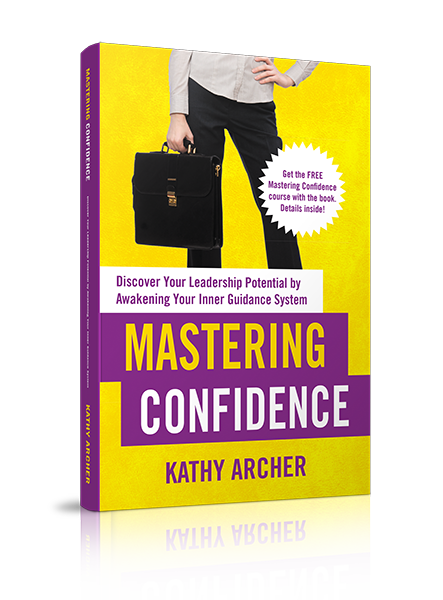
Available on Amazon
Archives
May 2024
|
|
Leadership TRAINING for Nonprofit Leaders
Become a confident and competent nonprofit Leader: Join The Training Library membership Executive and Leadership COACHING Leadership Coaching for Nonprofit Executives, Leaders and ManagerCoaching |
PODCAST for Nonprofit Leaders
The Surviving to Thriving podcast: Strategies, systems and support to lead your nonprofit with confidence FREE RESOURCES to Grow your Leadership Skills Free Leadership Training Resources, Worksheets and Templates |
Become a CONFIDENT LEADER
|

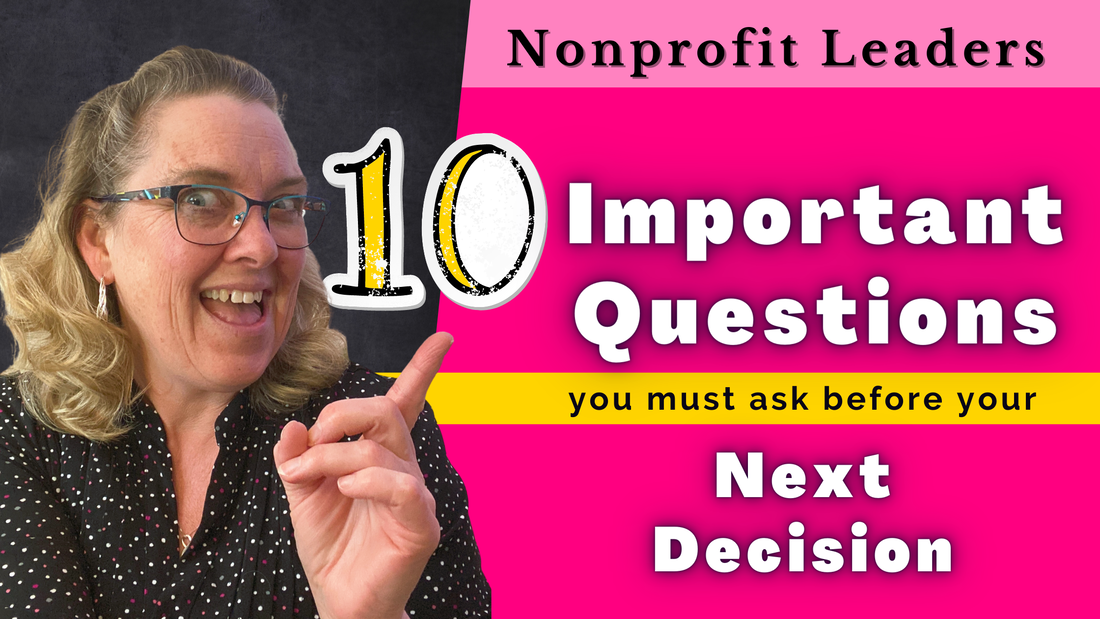
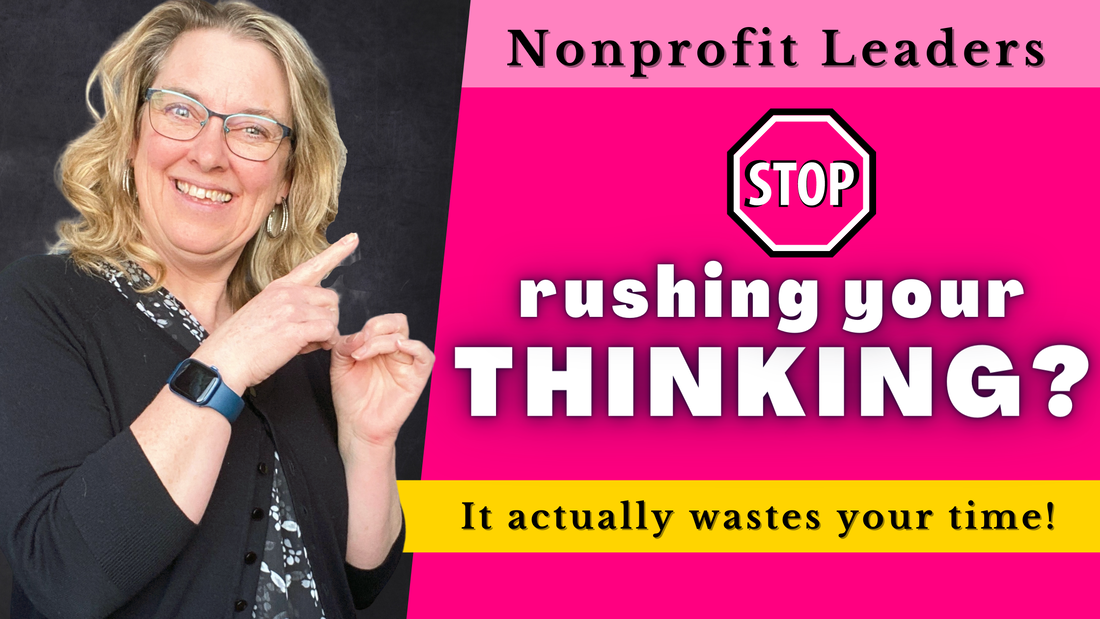
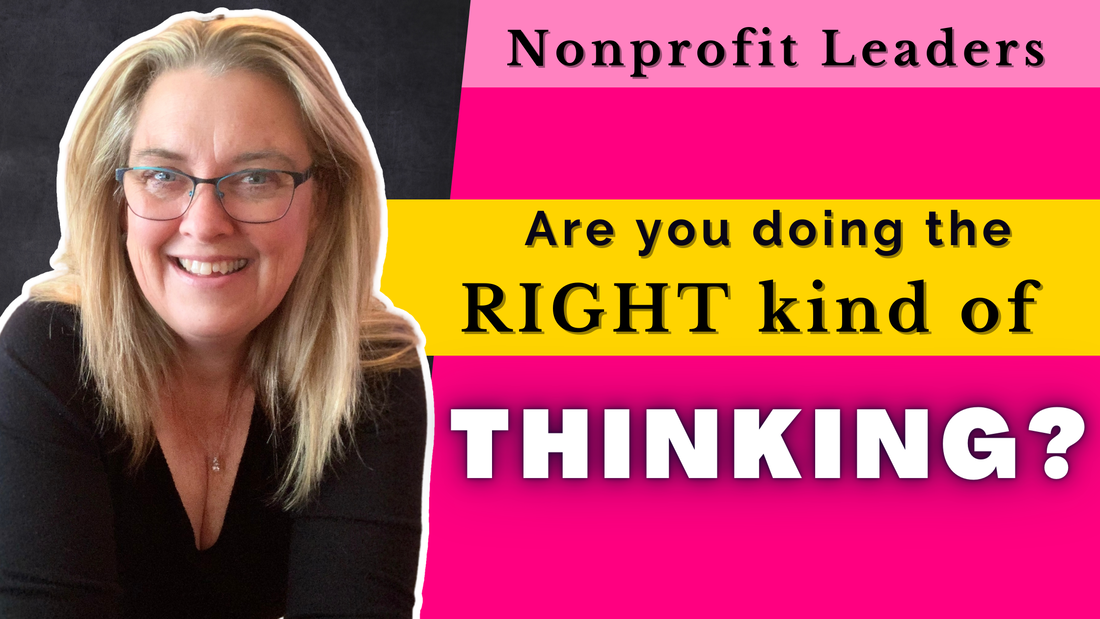

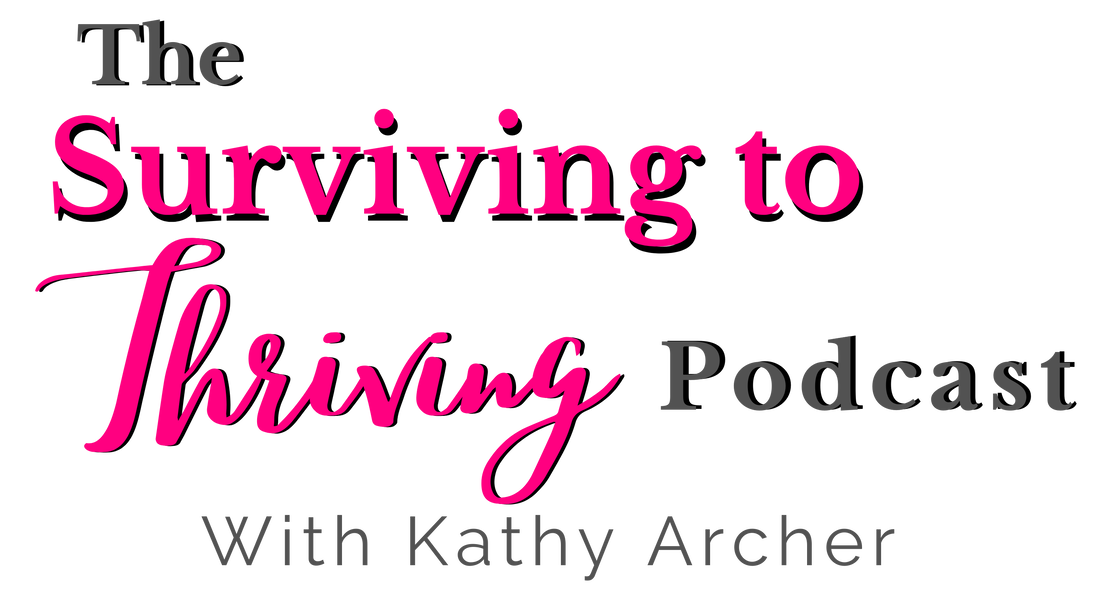
 RSS Feed
RSS Feed
